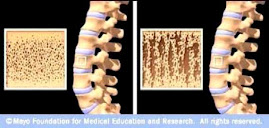Summary
The aim of the present study was to determine the efficacy
of strontium ranelate as a function of baseline fracture risk. Treatment with
strontium ranelate was associated with a significant 31% decrease in all
clinical osteoporotic fractures (vertebral fractures included). Hazard ratios
for the effect of strontium ranelate on the fracture outcome did not change
significantly with increasing fracture probability.
Introduction
Two previous studies
have suggested that the efficacy of intervention may be greater in the segment
of the population at highest fracture risk as assessed by the FRAX® algorithms.
The aim of the present study was to determine whether the anti-fracture
efficacy of strontium ranelate was dependent of the level of fracture risk.
Methods
The primary data of the two phase III studies (SOTI and
TROPOS) of the effects of strontium ranelate in postmenopausal osteoporosis
were combined. Country-specific probabilities were computed using the FRAX®
tool (version 2.0). The primary outcome variable comprised all clinical
osteoporotic fractures (including clinical vertebral fractures). Interactions
between fracture probability and efficacy were explored by Poisson regression.
Results
The 10-year probability of major osteoporotic fractures
(with BMD) ranged from 2.5% to 90.8%. FRAX®-based hip fracture probabilities
ranged from 0.1% to 90.3%. The incidence of clinical osteoporotic fractures
(vertebral fractures excluded) and morphometric vertebral fractures increased
with increasing baseline fracture probabilities. Treatment with strontium
ranelate was associated with a 31% (95% CI = 20–39%) decrease in osteoporotic clinical fractures and a 40%
decrease in vertebral fractures assessed by semiquantitative morphometry (95%
CI = 31–48%) Hazard ratios for the effect of strontium ranelate on
the fracture outcomes did not change significantly with increasing fracture
probability.
Conclusion
Strontium ranelate significantly decreased the risk of
osteoporotic clinical fractures, non vertebral fractures and morphometric
vertebral fractures in women. Overall, the efficacy of strontium ranelate was
not dependent of the level of fracture risk assessed by FRAX.
http://link.springer.com/article/10.1007/s00198-010-1474-0#page-1



No comments:
Post a Comment